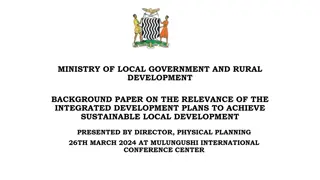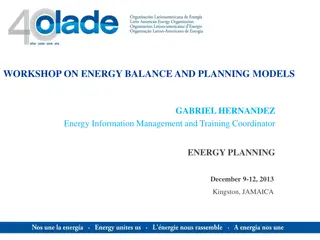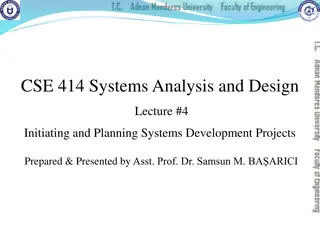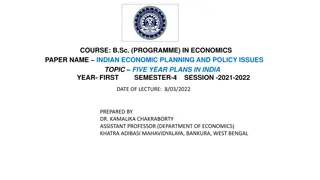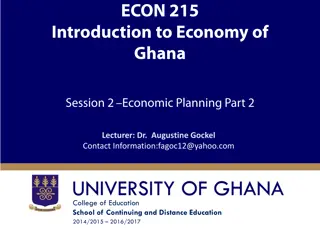Economic Analysis for Development Planning and Project Evaluation
Economic analysis plays a crucial role in evaluating both public and private investments, with a focus on identifying costs and benefits that may not always be captured in financial analyses. Externalities, such as infrastructure costs and benefits like flood control, are considered in economic assessments to provide a comprehensive view of project impacts on the economy. These analyses help decision-makers in developing countries make informed choices regarding resource allocation and project viability.
Download Presentation

Please find below an Image/Link to download the presentation.
The content on the website is provided AS IS for your information and personal use only. It may not be sold, licensed, or shared on other websites without obtaining consent from the author.If you encounter any issues during the download, it is possible that the publisher has removed the file from their server.
You are allowed to download the files provided on this website for personal or commercial use, subject to the condition that they are used lawfully. All files are the property of their respective owners.
The content on the website is provided AS IS for your information and personal use only. It may not be sold, licensed, or shared on other websites without obtaining consent from the author.
E N D
Presentation Transcript
Cont, Economic analysis is used primarily for evaluating public investments and has received increasing emphasis in recent years in in many developing countries. It is also applicable to private investments/projects. Course title: Development planning and project analysis II BY: s k Academic Year, 2012
Identification of Cost and Benefits of Economic Analysis Even though the procedures followed and the criteria used are the same, the values, which the NPV AND IRR assume, are different in economic analysis and financial analysis. The main factors, which explain this difference, are: 1. The items considered as inputs and outputs of the project; 2. The prices used in the valuation of inputs and output Course title: Development planning and project analysis II BY: s k Academic Year, 2012
1. Items considered as inputs and outputs Often, when it is analyzed from the enterprises viewpoint some real costs and benefits attributed to projects do not appear among its inputs and outputs. The main reason for excluding certain cost and benefits is that they are considered external to the enterprise. Course title: Development planning and project analysis II BY: s k. Academic Year, 2012 4
Cont, But costs or benefits viewed as external to the enterprise are internal when they are considered from the economy s angle; somebody pays for these external costs and somebody receives these external benefits, even if it is not the enterprise. Thus, to the extent that they can be measured and valued they are included in the calculations of the economic NPV AND IRR. Course title: Development planning and project analysis II BY: s,k. Academic Year, 2012 5
Cont, Good example of externalities is the costs incurred in providing the project area with infrastructure inputs, e.g.; access roads, energy lines, sewerage services; although these inputs are required by the project, often they serve other purposes too. Similarly, flood control benefits, for example, resulting from a hydroelectric power dam are real benefits to down stream farmers and the economy, but cannot be captured by the power authority for various reasons. Course title: Development planning and project analysis II BY: s k Academic Year, 2012 6
Cont, An externality (external effect) is a special class of good, which has the following characteristics: It is not purposely created by the project sponsor but is an incidental outcome of legitimate economic activity. It is beyond the control of the persons who are affected by it, for better or for worse. It is not traded in the market place. Course title: Development planning and project analysis II BY: s k. Academic Year, 2012 7
Cont, Since SCBA seeks to consider all costs and benefits, external effects need to be taken into account. The valuation of external effects is somewhat difficult because they are often intangible in nature and there is no market price, which can be used as a starting point. Their value is estimated by indirect means. Course title: Development planning and project analysis II BY: s k. Academic Year, 2012 8
Cont, For example: The benefit from the training program may be estimated in terms of the increased earning power of workers. The cost of pollution may be estimated in terms of the loss of earnings. The cost of noise may be inferred from the d/ces in rent b/n the noise-affected area and that of some other area & etc. Course title: Development planning and project analysis II BY: s k. Academic Year, 2012 9
Cont, The above examples serve to emphasize the difficulties in measuring external effects. [In view of this, some economists have suggested that these effects be ignored. In order to justify their suggestion, they argue that since a project is likely to have both beneficial and harmful external effects, one may not err much in assuming that the net effect would be zero. Course title: Development planning and project analysis II BY: s k. Academic Year, 2012 10
Cont, But, this argument, seemingly a rationalization for one's ignorance, lacks validity.] External effects must be taken into account wherever it is possible to do so. Even if these effects cannot be measured in monetary terms, some qualitative evaluation must be attempted. Course title: Development planning and project analysis II BY: s k Academic Year, 2012 11
2. Prices used Another d/ce b/n financial and economic analysis is that even inputs and outputs internal to both, the enterprise and the economy are valued differently. In financial analysis the rule is to value inputs and outputs at actual market prices, at the same time in economic analysis shadow or Efficiency prices are employed. Course title: Development planning and project analysis II BY: s k Academic Year, 2012 12
Cont, Consequently, using d/t prices will give d/t economic and financial NPV AND IRR even if the inputs and outputs are identical in physical terms. For example, the enterprise will have to pay workers the market wages in real Birrs (not in shadow ones), irrespective of what is believed to be their opportunity cost from the economy s viewpoint. Course title: Development planning and project analysis II BY: s k. Academic Year, 2012 13
Cont, Similarly, the enterprise will collect for its exports the equivalent of local currency calculated at the official exchange rate. Again, in financial analysis it is the actual expenditure and revenue, which matter, not shadow ones. Market prices, which form the basis for computing the monetary costs and benefits from the point of view of project sponsor reflect social values only under conditions of perfect competition. Course title: Development planning and project analysis II BY: Solomon k. Academic Year, 2012 14
Cont, When imperfections are obtained, market prices do not reflect social values. The common market imperfections found in developing countries are: (i) Rationing; Rationing of a commodity means control over its price and distribution. The price paid by a consumer under rationing is often significantly less than the price that would prevail in a competitive market. Course title: Development planning and project analysis II BY: s k. Academic Year, 2012 15
Cont, (ii) Prescription of minimum wage rates When minimum wage rates are prescribed, the wages paid to labour are usually less than what the wages would be in a competitive labour market free from such wage legislations. Course title: Development planning and project analysis II BY: s k Academic Year, 2012 16
Cont, (iii) Foreign exchange regulation. The official rate of foreign exchange in most of the developing countries, which exercise close regulation over foreign exchange, is typically less than the rate that would prevail in the absence of foreign regulation. This is why foreign exchange usually commands premium in unofficial transactions. Course title: Development planning and project analysis II BY: s k. Academic Year, 2012 17
Cont, In addition to the factors discussed above, the impact of the project on savings, its effect on redistribution, and the consideration for merit goods are also seen as the other factors that entail d/ces b/n financial and economic analysis of projects: i. Concern for Savings: Unconcerned about how its benefits are divided b/n consumption and savings, a private firm does not put differential valuation on savings and consumption. Course title: Development planning and project analysis II BY: s k. Academic Year, 2012 18
Cont, From a social point of view, however, the division of benefits b/n consumption and savings (which leads to investment) is relevant/appropriate. One Birr of benefits saved is deemed more valuable than a birr of benefits consumed. ii. Concern for Redistribution: A private firm does not bother how its benefits are distributed across various groups in the society. Course title: Development planning and project analysis II BY: s k. Academic Year, 2012 19
Cont, The society, however; is concerned about the distribution of benefits across different groups. One Birr of benefit going to a poor section is considered more valuable than a Birr of benefit going to an affluent section. iii. Merit wants: refer to goals and preferences that are not expressed in the market place. Course title: Development planning and project analysis II BY: s k. Academic Year, 2012 20
Cont, These goals and preferences are believed by policymakers to be in the larger interest. For example, the government may prefer to promote girls education. This is not required by consumers in the market place. Merit wants are not relevant from the private point of view. But they are important from the social point of view. Course title: Development planning and project analysis II BY: s k Academic Year, 2012
Cont, For the reasons discussed above the financial and economic analysis of a project will show a different picture, particularly as regards the NPV AND IRR. In analyzing public projects in particular both the financial analysis and the economic analysis should be conducted. This is especially user-to view a project from various angles and to obtain different perspectives. Course title: Development planning and project analysis II BY: s k. Academic Year, 2012 22
Cont, Decision makers need both profiles in order to evaluate a project and to design the necessary fiscal and monetary measures to meet its financial requirements. In deciding on the acceptance or rejection of such projects, the economic criterion is superior to the financial one, and when a project passes the economic test it is an acceptable project for the country and; Course title: Development planning and project analysis II BY: s k Academic Year, 2012 23
Cont, It should be implemented and the government will take the necessary financial and other measures to ensure its smooth operation. A project, for example, that shows very low, or even negative financial returns as a result of the fact that the major benefits it generates are external to and cannot be captured by the enterprise, might show acceptable economic returns when these benefits are considered as internal to the economy and are valued accordingly. Course title: Development planning and project analysis II BY: s k Academic Year, 2012 24
Cont, In this case the solution is to subsidize the enterprise sufficiently so that it will stay in operation and generate these benefits. However, although this is the economically rational approach, one should be careful with projects that pass the economic test but fail the financial test. Course title: Development planning and project analysis II BY: s k. Academic Year, 2012 25
Sunk cost Sunk costs are defined as those costs which have been incurred on the project before appraisal and which therefore cannot be avoided even if they are considered utterly wasteful. A sunk cost refers to an outlay already incurred in the past. When analyzing a proposed project, sunk costs are ignored. Course title: Development planning and project analysis II BY: s k. Academic Year, 2012 26
Cont, Economic and financial analyses consider only future returns to future costs. To save resources, it is preferable to stop a project midway whenever the expected future costs exceed the expected future benefits. On the other hand, although stopping a partially completed project may be more economical than finishing it, closing a project is often costly. Course title: Development planning and project analysis II BY: s k. Academic Year, 2012 27
Cont, For example, one may have to cancel partially completed contracts, and lenders may levy a penalty. Such costs have to be taken into account in deciding whether or not to close the project. Transfer Payments Transfer payments are payments made among different persons/economic agents/ but they are not related to any particular resources cost. Course title: Development planning and project analysis II BY: s k. Academic Year, 2012 28
Cont, Direct transfer payments redistribute national income and generally affect the government treasury. When looking at the project from the project entity's point of view, taxes and subsidies affect the benefits and costs of the project. When looking at the project from society's viewpoint, however, a tax for the project entity is an income for the government, and a subsidy for the entity is a cost to the government; the flows net out. Course title: Development planning and project analysis II BY: s k Academic Year, 2012 29
Cont, Hence transfer payments have to be excluded from all estimates of economic costs and benefits during the economic analysis of a project. It is to be noted that transfer payments affect the distribution of income. Course title: Development planning and project analysis II BY: s k. Academic Year, 2012 30
Determining Economic Values Adjustment for Transfer payments: The first step in adjusting financial prices to economic values is to estimate direct transfer payment. Direct transfer payments are payments that represent only the transfer of claims to real resources from one person in the society to another taxes and as such do not constitute a resource cost. Course title: Development planning and project analysis II BY: s k. Academic Year, 2012 31
Cont, The most common transfer payments are taxes, direct subsidies, and credit transactions that include (normally) loan receipts, repayments of principals, and etc. All these entries should be taken out before the financial accounts are adjusted to reflect economic values. Course title: Development planning and project analysis II BY: s k. Academic Year, 2012 32
Cont, Market prices represent shadow prices only under conditions of perfect competition. Hence, there is a need for developing shadow prices and measuring net economic benefits of goods/services in terms of these prices to guide the allocation of resources. It is also a set of prices that are believed to reflect better the opportunity cost. Course title: Development planning and project analysis II BY: s k. Academic Year, 2012 33
Cont, Rationale: Market prices in developing countries are generally often unreliable of the real worth of goods and services bought and sold in the market. Markets in most countries and particularly those of developing countries, often do not function in such a way that the prices and opportunity costs are the same. Course title: Development planning and project analysis II BY: s k. Academic Year, 2012 34
Cont, As a result, operation of the market mechanism does not lead to optimal allocation of scarce resources. A d/ce b/n market prices and opportunity cost occurs particularly in labour mkts b/se of statutory minimum wages and labor union pressure. Course title: Development planning and project analysis II BY: s k. Academic Year, 2012 35
Cont, Thus, in order to arrive at the economic values of these inputs it is necessary to adjust the prices to take into account of market imperfections. This suggests the need to developing efficiency shadow prices and measuring net economic benefits of goods/services in terms of these prices to guide the allocation of resources. Course title: Development planning and project analysis II BY: s k. Academic Year, 2012 36
Traded/tradable and non-tradable goods/commodities (inputs and outputs): oTraded goods: Traded goods are goods that are imported or exported. That is CIF for imports and FOB for exports. Under CIF agreement, the responsibility of the seller include transporting the goods to nearest port, loading them on a vessel (pot) and paying for the insurance and freight. Course title: Development planning and project analysis II BY: s k. Academic Year, 2012 37
Cont, FOB contracts relieve the responsibility of seller once the goods are shipped. Traded items are those for which FOB price is greater than domestic cost of production, or Imports, Marginal cost of production is greater than C.I.F price. Course title: Development planning and project analysis II BY: s k. Academic Year, 2012 38
Cont, Non-tradable inputs and outputs: A good is regarded as non-tradable when one or more of the following conditions are satisfied. If its import price (CIF price) is greater than its domestic cost of production and domestic cost of production is greater than its export price (F.O.B price) or simply CIF > DCP > FOB. Course title: Development planning and project analysis II BY: s k. Academic Year, 2012 39
Cont, If it is not traded because of government intervention by means of import bans or quotas. If it is not traded either because of its nature (bulkiness) or it is not economical to do so. Course title: Development planning and project analysis II BY: s k Academic Year, 2012 40
o The economic value of tradable (Valuation of Tradable): For tradable goods, the international price is the measure of its opportunity cost to the country. For tradable goods it is possible to substitute imports for domestic production and similarly it is possible to substitute exports for domestic consumption. Hence, the international price, also referred to as the boarder price, represents the real value of the good in terms of economic efficiency. Course title: Development planning and project analysis II BY: s k. Academic Year, 2012 41
o Valuation of non-tradable commodities: Some goods and services such as land, building, and electricity are not amenable to foreign trade. Hence, there is no boarder price for them. Economic value for non-traded items are defined in terms of marginal social cost (MSC) and marginal social benefit (MSB). Course title: Development planning and project analysis II BY: s k. Academic Year, 2012 42
Cont, The marginal social cost of a good is the value in terms of accounting prices of the resources required to produce an extra unit of the good, or Is the cost of producing one more unit of a good or services that falls on peoples other then the producer. It is the total cost that the society pays for the production of an extra unit of goods in question. Course title: Development planning and project analysis II BY: s k Academic Year, 2012 43
Cont, The marginal social benefit of a good is the benefit of an additional unit of a good or services that people other than the consumer of the goods or services enjoy. Therefore, the valuation of non-tradable is done as per the principles of shadow price discussed above. Course title: Development planning and project analysis II BY: s k. Academic Year, 2012 44
Cont The another way of determining economic value of non traded goods are; On output side; If the impact of the project is increase the consumption of the product in the economy, the measure of value is the consumers willing to pay. Course title: Development planning and project analysis II BY: s k Academic Year, 2012 45
Cont, On the input side; If the impact of the project is reduce the availability of inputs to other users, their willingness to pay for the input represents social value. Course title: Development planning and project analysis II BY:s k. Academic Year, 2012
Border Parity Pricing The economic benefits of producing tradable outputs and costs of using tradable inputs are measured by the border price of these inputs and outputs. The opportunity cost of tradable goods is defined by their border prices or value of a traded good at the border or port of entry (airport or sea port) of a country. Course title: Development planning and project analysis II BY: s k. Academic Year, 2012 47
Cont, The efficiency/shadow prices are border prices determined by international trade. Border price is the unit price of a traded good at a country s border or point of entry and it is either CIF or FOB prices , but net of taxes and subsidies. The project inputs and outputs are thus valued on the basis of international trade. Course title: Development planning and project analysis II BY: s k. Academic Year, 2012 48
Cont, The basic assumption here is that international market is less distorted than the domestic market and thus taking international price is more realistic to value the true cost of inputs and outputs. To move from market to shadow price analysis therefore, shadow prices must be expressed in terms of world prices to the project. Course title: Development planning and project analysis II BY: s k. Academic Year, 2012 49
Cont, Export parity price; is the price that a producer gets for its product if exported, or FOB export price minus the cost of getting the product from the farm or factory to the boarder. Import parity price; is the price that the purchaser pays for imported goods; or CIF import price plus transportation cost to the purchaser location. Course title: Development planning and project analysis II BY: s k. Academic Year, 2012 50
Cont Thus, for traded goods domestic margins, relating to transport will have to be adjusted to prices at the border to obtain values at theproject level. The decomposition of these margins is referred to as border parity pricing. Course title: Development planning and project analysis II BY: s k. Academic Year, 2012 51



